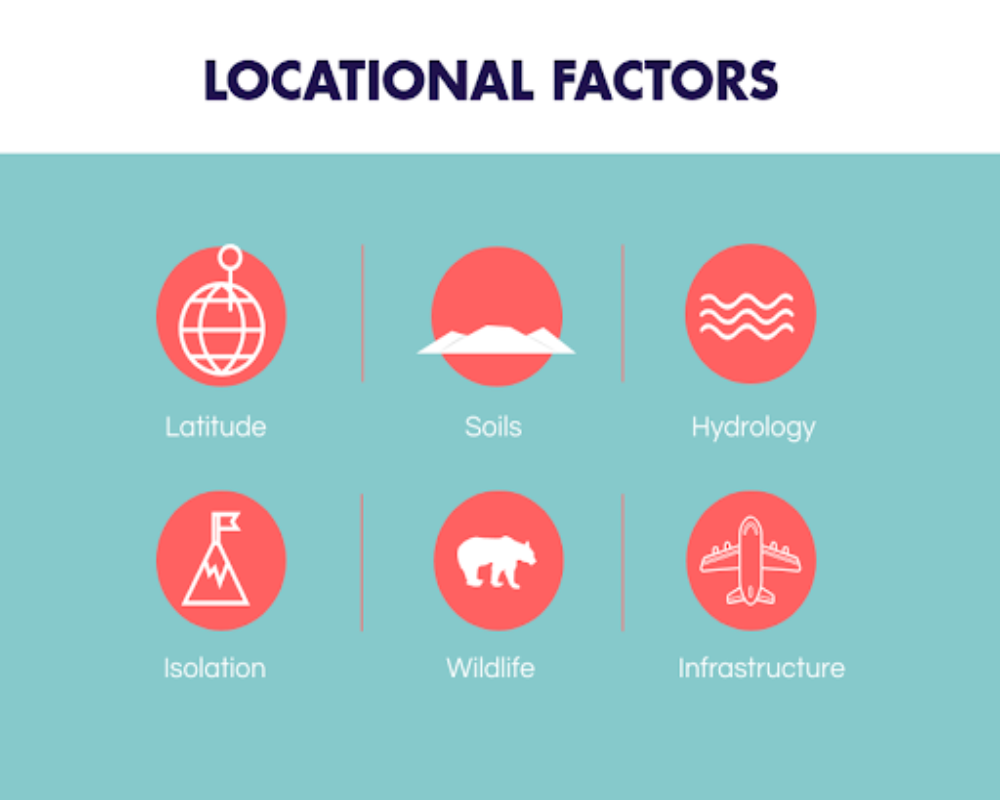Ideal Location Factors for Industrial Setup
Introduction
Choosing the right location is one of the most critical decisions in establishing a successful industrial setup. The location of an industry not only influences its operational efficiency but also affects long-term profitability, scalability, and compliance with regulatory frameworks. Several interdependent factors—ranging from infrastructure availability and market access to environmental and regulatory considerations—determine the suitability of a site for industrial development. A strategically selected location can reduce costs, enhance logistics, improve workforce productivity, and support sustainable operations.
Proximity to Raw Materials and Supply Chains
Access to raw materials is a fundamental factor in determining an industrial location, especially for manufacturing, processing, or heavy industries. Sites located near sources of essential inputs reduce transportation costs, ensure timely availability, and minimize supply chain disruptions. For example, a steel plant benefits from being close to iron ore mines, while a food processing unit thrives near agricultural hubs. Proximity to suppliers and intermediate goods producers also supports just-in-time manufacturing and operational agility.
Availability of Transportation and Connectivity
Efficient transportation is vital for moving raw materials into the facility and finished goods to market. The ideal industrial location should offer direct access to major highways, railways, ports, or airports. Multimodal transport options enable flexible, cost-effective logistics solutions and reduce lead times. Industrial corridors and logistics parks often provide this connectivity, making them attractive for warehousing, assembly, and distribution operations. Additionally, good internal road access for trucks and heavy machinery movement is essential for smooth daily operations.
Access to Utilities and Infrastructure
Industries require a stable supply of essential utilities, including electricity, water, telecommunications, and waste management. The availability and reliability of these services significantly impact production schedules and cost control. Sites within planned industrial zones or estates typically offer pre-installed infrastructure, reducing setup time and initial investment. Reliable power and water supply are especially critical for energy-intensive industries such as chemicals, textiles, or metallurgy.
Availability of Skilled and Unskilled Labor
Access to an adequate labor pool is crucial for sustaining production and operations. The ideal location offers proximity to regions with the right mix of skilled and unskilled workers, as well as access to training institutions, technical colleges, and vocational programs. In areas where labor shortages are common, higher costs or production delays can severely impact competitiveness. Industrial zones near urban centers or educational hubs often provide better labor availability and lower employee turnover.
Regulatory Environment and Zoning Compliance
Compliance with zoning laws, environmental regulations, and local land use policies is essential when selecting an industrial site. The ideal location should be within an area legally designated for industrial use and free from restrictive conditions that might hinder future expansion or operations. Special Economic Zones (SEZs), industrial parks, or clusters often offer streamlined approval processes, tax benefits, and relaxed regulatory norms that support easier project implementation and cost savings.
Proximity to Target Markets and Customers
Industries that rely on rapid delivery, high customer turnover, or regional market dominance benefit from being close to their customer base. Being situated near demand centers reduces logistics costs, ensures faster distribution, and strengthens client relationships. For example, consumer goods manufacturers may prefer locations close to metropolitan areas, while B2B industries may seek proximity to other industrial users or commercial partners.
Environmental Considerations and Land Characteristics
Environmental factors such as climate, topography, drainage, and pollution risk also influence location decisions. Industrial activities that involve hazardous materials or emissions require sites away from residential zones and ecologically sensitive areas. Flat terrain, well-drained soil, and minimal flood or earthquake risk are desirable characteristics that reduce construction challenges and enhance safety. Additionally, adherence to environmental impact norms and community expectations plays a vital role in long-term sustainability.
Cost of Land and Operational Expenses
Land cost, property taxes, and ongoing operational expenses are financial factors that can make or break the feasibility of an industrial setup. Affordable land with long-term leasing or ownership opportunities helps reduce upfront capital requirements. Locations with lower utility tariffs, tax incentives, and local subsidies can significantly improve profit margins. However, developers must balance cost savings with access to essential infrastructure and labor to ensure sustainable operations.
Future Expansion and Scalability
A forward-looking industrial site selection includes room for future growth. The ideal location should offer scope for horizontal or vertical expansion, easy utility upgrades, and regulatory support for increased production capacity. Industrial areas with master plans or government-backed development schemes often provide long-term certainty in terms of zoning stability, infrastructure upgrades, and access to growth corridors.
Conclusion
Selecting the ideal location for an industrial setup is a multi-dimensional decision that integrates logistical, economic, regulatory, environmental, and social factors. A well-chosen site enhances operational efficiency, reduces costs, supports scalability, and ensures compliance with laws and community expectations. As competition intensifies and industries adapt to new technologies and market demands, the importance of strategic site selection becomes even more significant. Thoughtful location planning not only sets the foundation for industrial success but also contributes to long-term sustainability and resilience in a rapidly changing global landscape.
Hashtags
#IndustrialSetup #LocationFactors #BusinessLocation #SiteSelection #ManufacturingHub #LogisticsEfficiency #InfrastructureDevelopment #ProximityToSuppliers #AccessToMarkets #SkilledLabor #ZoningRegulations #CostOfLand #UtilitiesAvailability #TransportationAccess #EnvironmentalImpact #EconomicIncentives #SafetyStandards #TechnologyAccess #Sustainability #GrowthPotential


